
How Do the Bins Work
We have learned about “bins” from a combination of ATIPs for the Standard Operating Procedures of Visa Offices (in this case Delhi) and from an ATIP about IRCC’s Advanced Analytics process.
Bins are important, because as the image suggests, applicants are scored and triaged into different bins for different officers to process. As we have shared in earlier posts (including here), whether a case is Officer’s Rules, Tier 1, Tier, 2, or Tier 3 likely has a huge predictor of whether an application will be ultimately approved. Let’s dig further into how bins can operate.
First, bin assignments are the model outputs from the Advanced Analytics model. I have not yet figured out if they pre-existed the three Tier system, but we know now that the Bins are based on Tiers (more on this later).
In Cognos, IRCC uses datasets to score application, allowing for the creation of Bins.

We know also that the Bins are organized depending on unique features that the application raises. In short, like cases are being processed together, and split between the need for senior staff review or not.

From this India SOP ATIP we learn more about what each Bin might look like. For example, we know that there is at least a Tier 2 for Adverse history, a Tier 2 for not Tier 1 cases (remember that if the case does not fit the Tier 1 model (score high) it could be sorted into Tier 2.
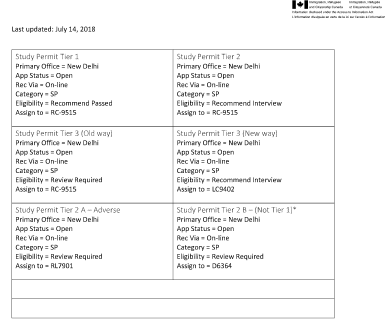
In the case of study permits, we also know that Tiering for Tier 2 can also occur for cases where there is no LOA/CAQ, Minor or Secondary Students, Areas or School of Concern, other Reqs Pending, TRV + SP cases (where they hold both), Bona Fides, Info-Sharing, Temporary PR (assuming this may be for those with dual intention OR where there are PR siblings), Temporary CC (which could also mean same, but for Canadian Citizens), and Third Party Nationals (that we know are often refused on immigration status).
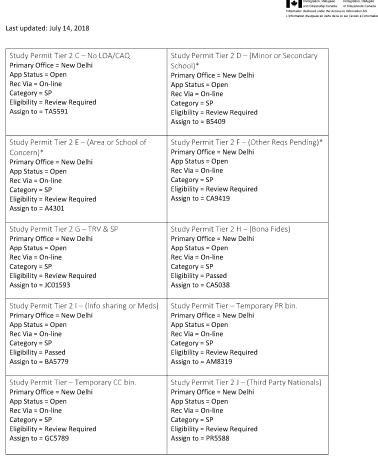
What this means is that you are sorted into piles (triaged if you will) and that the assignments to what we historically thought of as just “Officers” can also align with bins. Likely, as Advanced Analytics takes over it may no longer be an Officer but rather an AI process itself that is maintained by an Officer (the Officer of Record) who merely changes the inputs.
We know from the India Standard Operating Procedures (SOP) that the Officers are also required to document their decisions made – confirming again our theory that Officers are assigned to specific Bins.
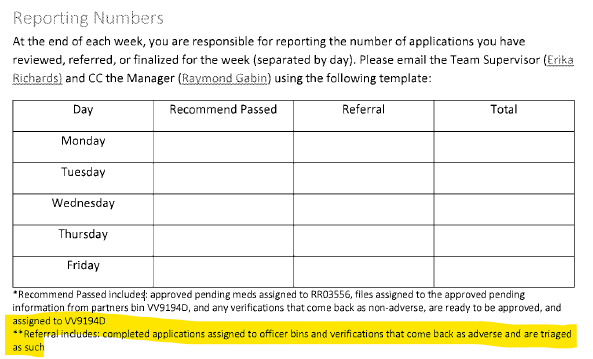
In the Privacy Impact Assessment for the China AA-TRV model, there were major concerns raised that the bin information (which is redacted for Applicant’s) would be accessible by other organization such as CBSA and CSIS who will want to know what the Bins means and could be utilized for their own predictive analytic modelling.
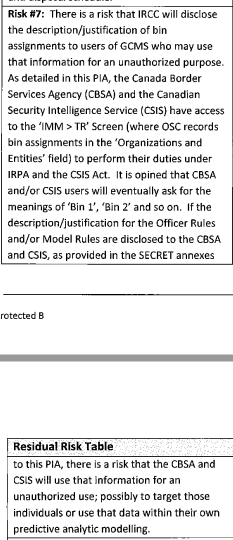
The recommendation to address the issue was to not disclosure Bin names/descriptions. Yet, to me it is concerning that Bin names are available to these organizations but not to applicants who get redacted GCMS notes.
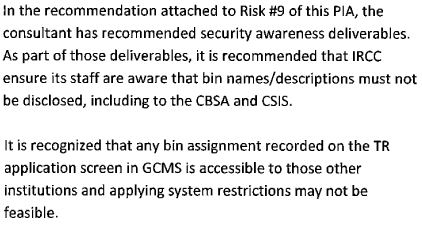
In related discussion on the PIA, we also note that IRCC was concerned about clerical errors in assigning Bins and as well the automation of the Bin entries in GCMS. Because the information we have is quite dated (I mean by years – going back to my theory on how far behind we are), I do have reasons to believe the bin assignments are not automated into GCMS and will be into GCMS’ eventual replacement.
What We Don’t Know – How Scoring Works and How Scoring Influences Result
We know that scoring applications exist and that scoring through the production model is the main way to determine the sorting of applications into tiers and into bins. We also know that this process have made Officers more efficient, as the Advanced Analytics sets up the file for them.


We still do not know how the scoring system works in practice (we are learning more about what constitutes a Tier 1 Application, the subject of our next blog), what the impact of being Tier 2 or Tier 3 is. Are there guidance at processing offices to fast-track all Tier 1, but refuse all Tier 3. If the criteria for Tier 1 is what we know – single applicant, with specific country of residences, what differentiates a Tier 2 with a Tier 3. How does an Officer dealing with a Tier 2 or Tier 3 bin actually approve cases or go against the statistical refusal grain? What if the criteria of Tier 3 is based on socioeconomic/racial bias, unchecked by the current system (lack of independent oversight).
Moving to our role as practitioners, if our clients are destined for Bins and if IRCC already has the stats and outcomes locked in – do our submission letters, support letters, written advocacy have any role to play other than to be an eventual Federal Court bail out? What if the Federal Court buys the privacy/blackbox/efficiency of tribunal argument and endorse a different standard of reasonableness for temporary resident applications with whom they have said very little procedural fairness is owed?
The story continues……



